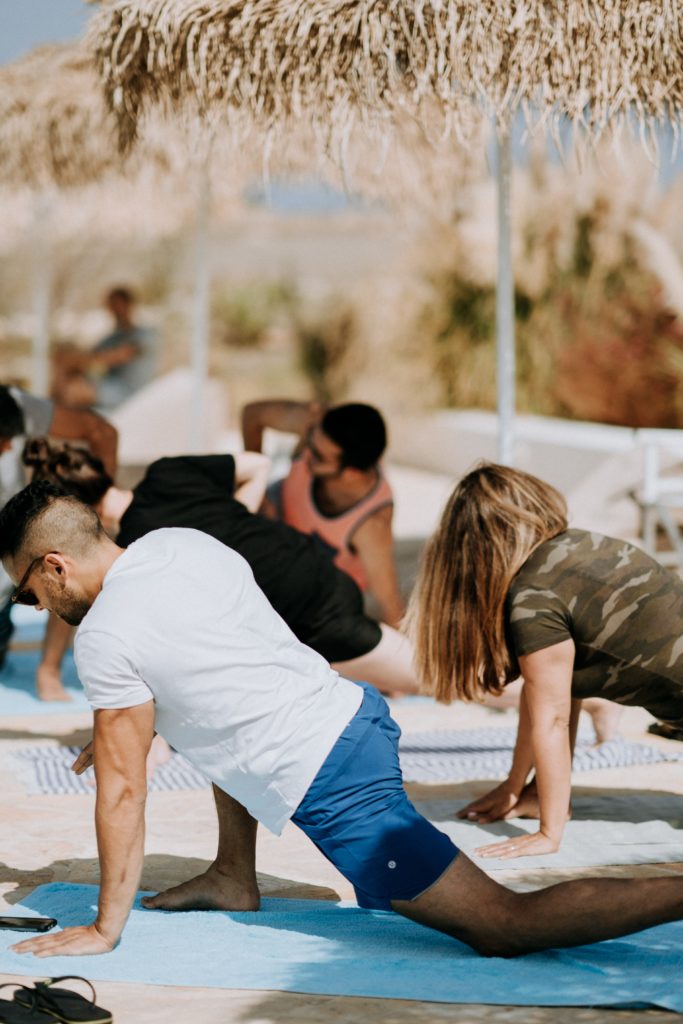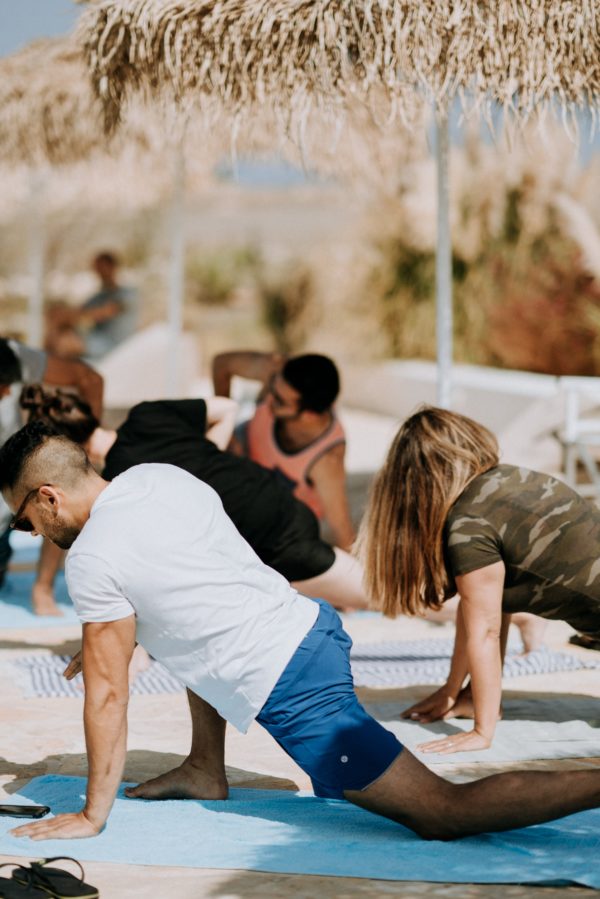by Mercedes (Didi) von Deck, MD

The Feldenkrais Method® of somatic education and yoga are both practices that help people feel more at home in their bodies. Both use movement as a means for healing and as a means for transformation. While the ways the body moves in yoga and the Feldenkrais Method are very different, the two practices are beautifully complementary. One doesn’t need to choose between them. In fact, the Feldenkrais Method can enhance a yoga practice, and the awareness that practicing yoga brings can expand through the Feldenkrais Method.
Key differences
The physical practice of yoga focuses on asana (poses) which place the body into certain positions, and holding these asanas helps strengthen and lengthen muscles. Feldenkrais® Awareness Through Movement® does not involve stretching or strengthening.
In Feldenkrais lessons, movement itself is what captures the attention of the nervous system. Small, slow, easy movements draw attention to relationships between different parts of the body, and through these movements the brain learns how to orchestrate efficient, supported, and integrated actions. By playing with tiny movements and exploring different and unusual ways to move the body, unnecessary muscle tension is released and movement becomes more coordinated and free. Fluid motion with less pain results. Feldenkrais lessons may, in fact, be more accessible initially for people with injuries, pain, stiffness or other limitations of movement than many forms of western yoga.
While some yoga asanas may require effort to achieve the pose, the Feldenkrais Method asks that you take effort out. You are invited to explore different ways of moving while slowing down enough to sense the process. Positions familiar to the yoga student can be found in many Feldenkrais Awareness Through Movement lessons, but postures are not held. You feel the body through movement, not shape.
Our culture teaches us that working harder is the way to achieve, and as a yoga teacher, I see many yoga students straining in their asana practice. The Feldenkrais Method invites improvement by decreasing the force applied. When the effort is reduced, the brain can notice differences between variations of simple movements and will naturally choose the most efficient way of moving. Movement becomes easier. Yoga postures become easier.
Key commonalities
Both yoga and the Feldenkrais Method ask one to pay attention to the breath. Pranayama, or breath control, is thought to help control life force (prana), and many styles of yoga link breath to movement. In Feldenkrais Awareness Through Movement explorations, the breath and movement are also frequently coordinated, but without the desire to control the breath. Feldenkrais lessons teach strategies for releasing tension in the belly and rib cage so that breath can become naturally expansive and free.
The act of continually bringing attention to the body and the breath with both the Feldenkrais Method and yoga helps students stay in the present moment, and helps quiet the incessant thoughts that can cloud the mind. In yoga, focusing on the poses and the breath keeps the mind steady. In a Feldenkrais class, the task of bringing attention to novel and underexplored areas keeps the mind from wandering and opens new avenues for inquiry. Noticing how each vertebra moves or the path the shoulder blade takes sliding across the back opens us to seeing ourselves more clearly without judgment. Turning the attention inward and focusing the mind on our inner experiences in both practices can calm the mind and relax the body.
Results
Exploring the organization of the body and our habits of posture and movement through yoga and the Feldenkrais Method can occasionally result in some discomfort, both internally and externally. However, this discomfort is an opportunity to see “what is” and to make changes. We can notice our reactions to being asked to hold certain postures in yoga, or to pay attention to small movements in a Feldenkrais lesson. Sometimes those tiny movements can lead previously sidelined muscles groups to participate more fully, allowing new possibilities to arise as dormant muscles support activities in a more functional manner. Occasionally muscles can feel a little sore. The movements can also release held patterns of tension, allowing unnecessarily tight muscles to relax and let go so that the skeleton can provide better support and discomfort can dissipate.
By changing how we feel in our bodies, both yoga and the Feldenkrais Method have the power to change how we react to life. Both practices create space for us to pause before reacting. By creating options for easier movement, the Feldenkrais Method also creates options for choosing how to be in the world. We can flow a little more freely through life. Yoga helps students find inner as well as outward strength, and both practices teach students how to do movements they may not have imagined they could do.
Didi’s experience
I discovered the Feldenkrais Method in college while taking a modern dance class. I spent my whole childhood following academic pursuits and literally viewed my body as the container for my brain. This view was wreaking havoc on my mental state. My Feldenkrais classes grounded me and helped me breathe. I didn’t understand what was happening, but I found myself finally able to make decisions that worked for me.
I started a yoga practice much later in life, and am grateful to yoga for allowing me to feel my body in a new way. I have developed more strength and flexibility. As I age, I realize that keeping my body strong is important. However, keeping fluidity of movement is just as important, for what the body does, the mind follows.
New connections
Discovering new relationships with our bodies and developing our capacity for new movement allows us to connect to ourselves is a whole new way. Both yoga and the Feldenkrais Method create the means to explore and transform our patterns of moving and our habits of being. Both help us expand our awareness of ourselves. And with greater awareness, we become capable of reaching our full potential.
________

Didi (Mercedes) von Deck, MD is a fourth year trainee in the Boston Feldenkrais Training with Aliza Stewart. She is also a practicing orthopaedic surgeon and a certified yoga teacher. She began studying the Feldenkrais Method in the 1980’s when she started competing internationally in ballroom dance. She continues to dance and study movement. By combining her understanding of orthopaedics and human anatomy and physiology with her knowledge gained from years of practicing Ashtanga yoga, dance and the Feldenkrais Method, she brings a unique perspective to working with her patients and students in order to improve their functioning and well-being. For more information, visit her Facebook page.

